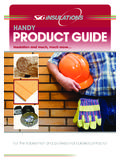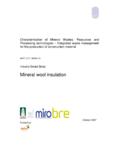Transcription of TIMSA guidance for achieving compliance with Part L of …
1 The Building Regulations 2000 TIMSA guidance for achieving compliance with Part L of the Building Regulations DOMESTIC AND NON-DOMESTIC HEATING, COOLING AND VENTILATION GUIDE compliance with APPROVED DOCUMENTS L1A: NEW DWELLINGS L1B: EXISTING DWELLINGS L2A: NEW BUILDINGS OTHER THAN DWELLINGS AND L2B: EXISTING BUILDINGS OTHER THAN DWELLINGS Edition March 2006 TIMSA HVAC compliance Guide March 2006 TIMSA Thermal insulation Manufacturers & Suppliers Association Formed in 1978, TIMSA is a trade association comprising UK manufacturers, consultants, suppliers and distributors of the whole range of thermal insulation materials, ancillaries and services.
2 TIMSA is committed to raising standards and awareness of the need to insulate and the part insulation can play in the protection of the environment. Further information is available on TIMSA 's web site Association House, 99 West Street, Farnham, Surrey GU9 7EN Tel: 01252 739154 Fax: 01252 739140 Although care has been taken to ensure, to the best of our knowledge, that all data and information contained herein is accurate to the extent that it relates to either matters of fact or accepted practice or matters of opinion at the time of publication, the Thermal insulation Manufacturers and Suppliers Association assumes no responsibility for any errors in or misinterpretations of such data and/or information or any loss or damage arising from or related to its use.
3 TIMSA 2006 ISBN: 0 9533319 0 3 TIMSA HVAC compliance Guide March 2006 3 CONTENTS 1 FOREWORD ..4 2 HOW TO USE THIS GUIDE ..5 Who the Guide is for and which Sections are relevant to each audience ..5 Scope of the guidance ..5 Summary ..7 3 DEVELOPMENT OF METHODOLOGY ..7 Linkage with the Part L Consultation and the Regulatory Impact Assessment Assumptions ..7 Financial criteria - payback ..8 Inclusion of the Social Cost of Selection of Standardised Scenarios for Evaluating compliance ..10 4 CONSIDERATION OF PRACTICALITY ..13 Linkage to Pipe Selection of Reference Thermal 5 WHERE TO INSULATE AND MINIMUM PERFORMANCE REQUIREMENTS ..14 Dwellings ..14 Buildings other than 6 INDICATIVE insulation Dwellings.
4 18 Buildings other than 7 OTHER REASONS FOR Frost Condensation Control ..30 Personnel 8 FURTHER READING .. 31 9 CONTACTS with TIMSA ..31 10 ANNEX 1 BACKGROUND TO THE DEVELOPMENT OF THE GUIDE ..32 The UK s Climate Change Programme commitments ..32 The importance of pipe and duct insulation in CO2 terms ..34 The Energy Performance in Buildings The resulting revision of the Building Linkage with other compliance Guides ..38 4 TIMSA HVAC compliance Guide March 2006 1 FOREWORD TIMSA has been active in assessing the contribution of insulation to the UK carbon emission reduction goals since these were re-established in 1997. The commitment to 20% reduction in CO2 emissions by 2010 has always been recognised as ambitious and certainly not achievable without substantial contributions from the energy efficiency industry in general and thermal insulation in particular.
5 The development of the Energy Performance in Buildings Directive in the early part of this decade and its finalisation in January 2002 began to put shape on the likely future requirements for the built environment in the UK. TIMSA has been at the forefront of evaluating the implications for the industry; both by participation in the Part L Industry Advisory Groups (IAGs) and in the revision of standards which might influence the fulfilment of the Directive s objectives. with respect to pipe and duct insulation specifically, a TIMSA Sub-Group was formed in early 2004 to assist in developing minimum requirements for the 2006 revision of Part L based on cost-effectiveness criteria being established at the time within the IAGs and later re-assessed during and after the consultation process that took place in mid-2005.
6 Throughout this process, the Sub-Group has stuck firmly to its task of defining the minimum criteria for pipes and ducts in both domestic and non-domestic environments. This scope has included all hot water, heating and cooling applications. As Tier 2 compliance Guides in both domestic and non-domestic sectors began to emerge in early 2005, the TIMSA Sub-Group also became engaged in ensuring that pipe and duct insulation was consistently and appropriately covered. In all the Sub-Group has met over 20 times in pursuit of these objectives and TIMSA would like to use this opportunity thank each participant and their respective employers for the support provided to the process. The following participants and companies were involved.
7 Nick Ralph (Chair of Sub-Group) Rockwool Limited Pat Johnson Armacell Vance Brownhill Armacell Nikolaus Odenwald Armacell David Davies ex-Armacell John Robertson NMC (UK) Limited Les Johnson Deeside Technical Services/Union Foam Pat Testa Sheffield insulation Geoff Wright KingspanTarec Limited Stephen Wise Knauf insulation In addition, TIMSA would wish to acknowledge the co-ordination and secretarial role played by Paul Ashford of Caleb Management Services Limited, who was also responsible for the initial development of this document for TIMSA review and approval.
8 TIMSA will be continuing to support the requirements of the industry through the implementation of the 2006 Part L Revisions and is already looking at the implications of future revisions of Part L which will be scheduled for 2010. The continued inter-linkage with BS 5422 will be a further focus of future work. Patrick Hall Chairman TIMSA March 2006 TIMSA HVAC compliance Guide March 2006 5 2 HOW TO USE THIS GUIDE Who the Guide is for and which Sections are relevant to each audience The primary purpose of the TIMSA HVAC guidance for achieving compliance with Part L of the Building Regulations is to provide a single point reference for all compliance issues related to the treatment of pipework and ductwork insulation within the 2006 version of Part L of the Building Regulations.
9 The guidance is targeted at three different audiences: 1. Those seeking to understand the role and significance of pipework and ductwork insulation in the wider development of climate change policy within the built environment [Policy Significance] 2. Those seeking to understand the basis on which the current performance standards have been derived and needing to know how to replicate the calculations for other scenarios ( products with thermal performance other than those listed) [Basis of Calculation] 3. Those seeking to know simply when to use this Guide and an indicative assessment of the thicknesses of insulation required [ guidance for compliance ] The following table provides a directory of sections relevant to each of these audiences.
10 Table 1 Sections of relevance to specific audiences Section Policy Significance Basis of Calculation guidance for compliance 2 How to use this Guide X X X 3 Background to the development of the Guide X 4 Development of methodology X 5 Consideration of practicality X 6 Where to insulate and minimum performance X X 7 Indicative insulation thicknesses X X 8 Other reasons for insulating X X 9 Further reading X X 10 Contact point at TIMSA X X X Scope of the guidance This guidance is specifically targeted at the implementation of the 2006 revision of Part L of the Building Regulations covering the conservation of heat and power . It does not provide specific guidance on other aspects of pipework and ductwork insulation performance and users of the Guide need to take account of other reasons for insulating which might be operative (see Section 7).



